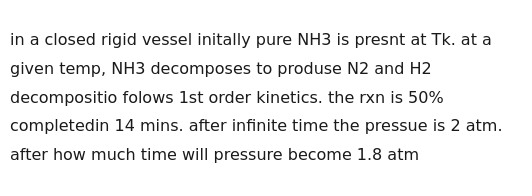Question
Question: in a closed rigid vessel initally pure NH3 is presnt at Tk. at a given temp, NH3 decomposes to produ...
in a closed rigid vessel initally pure NH3 is presnt at Tk. at a given temp, NH3 decomposes to produse N2 and H2 decompositio folows 1st order kinetics. the rxn is 50% completedin 14 mins. after infinite time the pressue is 2 atm. after how much time will pressure become 1.8 atm

It takes approximately 32.5 minutes for the pressure to become 1.8 atm.
Solution
Solution:
For the decomposition of NH₃, the balanced reaction is
2 NH₃(g) → N₂(g) + 3 H₂(g).
Let the initial moles of NH₃ = 2 (for convenience). If a fraction y of NH₃ decomposes then:
- Moles of NH₃ remaining = 2(1 – y)
- Moles of products formed = N₂: y and H₂: 3y
- Total moles at time t = 2(1 – y) + y + 3y = 2 + 2y
Since the vessel is rigid and isothermal, pressure ∝ number of moles. Let initial pressure P₀ correspond to 2 moles. Then,
P₀ ∝ 2 and P∞ ∝ 2 + 2(1) = 4.
Given that P∞ = 2 atm, it follows that P₀ = 1 atm and the pressure at time t is
P(t) = 1 atm × (1 + y).
At 50% completion, y = 0.5, so:
P = 1(1 + 0.5) = 1.5 atm
and the half-life t₁/₂ = 14 min. Because the reaction is first order in NH₃, we have
[NH₃] = [NH₃]₀ e^(–kt).
Since the moles of NH₃ remaining are 2(1 – y), the fraction unreacted is (1 – y) = e^(–kt).
For the pressure of 1.8 atm at some time t, 1 + y = 1.8 ⟹ y = 0.8.
Thus,
e^(–kt) = 1 – y = 0.2 ⟹ –kt = ln(0.2) ⟹ t = –(1/k) ln(0.2) = (ln 5)/k.
Using the half-life relation for first order kinetics, t₁/₂ = ln 2/k ⟹ k = (ln 2)/14.
Substitute k into the time expression: t = (ln 5) / (ln 2/14) = 14 (ln 5)/(ln 2).
Numerically, with ln 5 ≈ 1.609 and ln 2 ≈ 0.693: t ≈ 14 × (1.609 / 0.693) ≈ 14 × 2.322 ≈ 32.5 min.
Minimal Explanation:
- In a rigid vessel, total moles and hence pressure is proportional to (initial moles + moles from reaction) = 2 + 2y.
- With P₀ = 1 atm and final pressure 2 atm, P(t) = 1(1 + y). At 1.8 atm, y = 0.8.
- First order decay: (1 – y) = e^(–kt); with t₁/₂ = 14 min, k = ln2/14.
- Solve: e^(–kt) = 0.2 ⟹ t = 14 ln5/ln2 ≈ 32.5 min.
